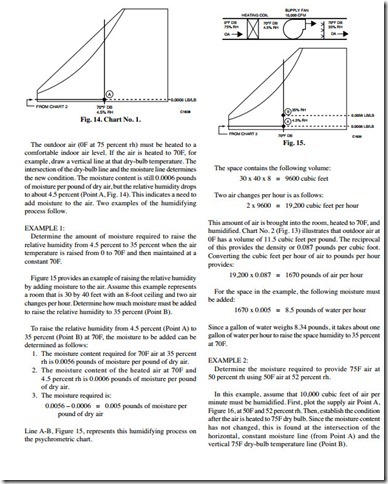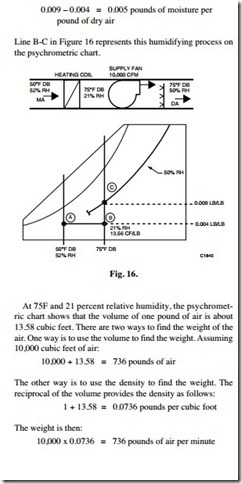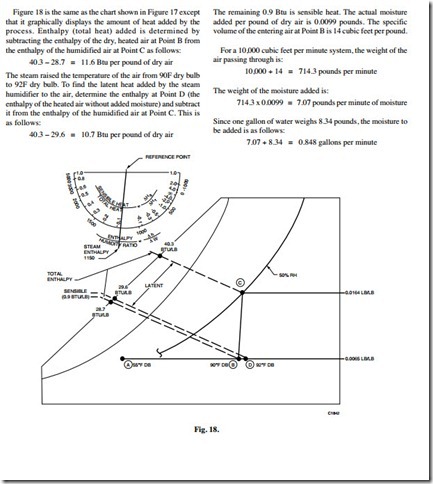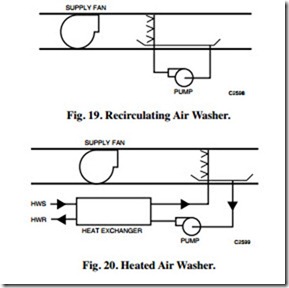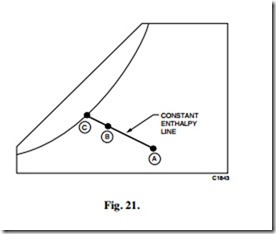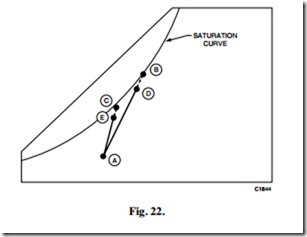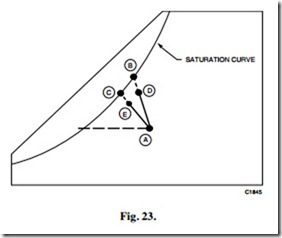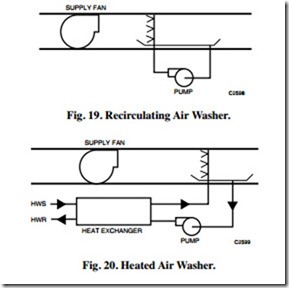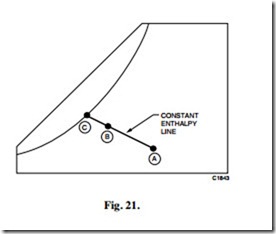HUMIDIFYING PROCESS
BASIC PROCESS
The humidifying process adds moisture to the air and crosses constant moisture lines. If the dry bulb remains constant, the process involves the addition of latent heat only.
Relative humidity is the ratio of the amount of moisture in the air to the maximum amount of moisture the air can hold at the same temperature and pressure. If the dry-bulb temperature increases without adding moisture, the relative humidity decreases. The psychrometric charts in Figures 13 and 14 illustrate what happens. Referring to Chart No. 2 (Fig. 13), outdoor air at 0F dry bulb and 75 percent rh (Point A) contains about 0.0006 pounds of moisture per pound of dry air. The 0.0006 pounds of moisture per pound of dry air is carried over to Chart No. 1 (Fig. 14) and a horizontal line (constant moisture line) is drawn.
The air at Points A and B has 0.004 pounds of moisture per pound of air. While the moisture content remains the same after the air is heated to 75F (Point B), the relative humidity drops from 52 percent to 21 percent. To raise the relative humidity to 50 percent at 75F, find the new point on the chart (the intersection of the 75F dry-bulb line and the 50 percent rh curve or Point C). The moisture content at this point is 0.009 pounds of moisture per pound of dry air. Calculate the moisture to be added as follows:
0.009 – 0.004 = 0.005 pounds of moisture per pound of dry air
Line B-C in Figure 16 represents this humidifying process on the psychrometric chart.
If each pound of dry air requires 0.005 pounds of moisture, then the following moisture must be added:
736 x 0.005 = 3.68 pounds of moisture per minute
This converts to:
3.68 x 60 minutes = 220.8 pounds per hour
Since one gallon of water weighs 8.34 pounds, the moisture to be added is as follows:
220.8 + 8.34 = 26.5 gallons per hour
Thus, a humidifier must provide 26.5 gallons of water per hour to raise the space humidity to 50 percent at 75F.
STEAM JET HUMIDIFIER
The most popular humidifier is the steam-jet type. It consists of a pipe with nozzles partially surrounded by a steam jacket. The jacket is filled with steam; then the steam is fed through nozzles and sprayed into the air stream. The jacket minimizes condensation when the steam enters the pipe with the nozzles and ensures dry steam for humidification. The steam is sprayed into the air at a temperature of 212F or higher. The enthalpy includes the heat needed to raise the water temperature from 32 to 212F, or 180 Btu plus 970 Btu to change the water into steam. This is a total of 1150 Btu per hour per pound of water at 0 psig as it enters the air stream. (See Properties of Saturated Steam table in General Engineering Data section). The additional heat added to the air can be plotted on Chart No. 1 (Figure 17) to show the complete process. In this example, air enters the heating coil at 55F dry-bulb temperature (Point A) and is heated to 90F dry-bulb temperature (Point B) along a constant moisture line. It then enters the humidifier where the steam adds moisture and heats the air to Point C.
Figure 17 also shows use of the protractor nomograph. Assume the relative humidity of the air entering the humidifier at Point B is to be raised to 50 percent. A process line can be constructed using the protractor nomograph. The total heat of the entering steam in Btu per pound is located on the enthalpy/humidity ratio scale (Dh / DW) of the nomograph. This value, 1150 Btu per pound, is connected to the reference point of the nomograph to establish the slope of the process line on the psychrometric chart. A parallel line is drawn on the chart from Point B up to the 50 percent relative humidity line (Point C). The Line B-C is the process line. The Line X-Y (bottom of the chart) is simply a perpendicular construction line for drawing the Line B-C parallel to the line determined on the nomograph. Note that the dry-bulb temperature increased from 90 to 92F.
This converts to:
0.848 x 60 minutes = 50.9 gallons per hour
Recalling that the steam added 11.6 Btu per pound of dry air, the total heat added is:
714.3 x 11.6 = 8286 Btu per minute
This converts to:
8286 x 60 minutes = 497,160 Btu per hour
Summarized, a steam humidifier always adds a little sensible heat to the air, and the Process Line B–C angles to the right of the 90F starting dry-bulb line because of the added sensible heat. When the process line crosses the moisture content lines along a constant dry-bulb line, only latent heat is added. When it parallels a constant, horizontal moisture line, only sensible heat is added.
AIR WASHERS
Air washers are also used as humidifiers particularly for applications requiring added moisture and not much heat as in warm southwestern climates. A washer can be recirculating as shown in Figure 19 or heated as shown in Figure 20. In recirculating washers, the heat necessary to vaporize the water is sensible heat changed to latent heat which causes the dry- bulb temperature to drop. The process line tracks the constant enthalpy line because no total heat is added or subtracted. This process is called “adiabatic” and is illustrated by Figure 21. Point A is the entering condition of the air, Point B is the final condition, and Point C is the temperature of the water. Since the water is recirculating, the water temperature becomes the same as the wet-bulb temperature of the air.
The next two psychrometric charts (Fig. 22 and 23) illustrate the humidifying process using a heated air washer. The temperature to which the water is heated is determined by the amount of moisture required for the process. Figure 22 shows what happens when the washer water is heated above the air dry-bulb temperature shown at Point A. The temperature of the water located at Point B on the saturation curve causes the system air temperature to settle out at Point D. The actual location of Point D depends upon the construction and characteristics of the washer.
As the humidity demand reduces, the water temperature moves down the saturation curve as it surrenders heat to the air. This causes the water temperature to settle out at a point such as Point C. The final air temperature is at Point E. Note that the final air temperature is above the initial dry-bulb temperature so both sensible and latent heat have been added to the air.
Figure 23 illustrates a heated washer where the water temperature is between the dry-bulb and wet-bulb temperatures of the air. The air is humidified but also cooled a little. Point B represents the initial and Point C the final temperature of the water with reduced humidity demand. Point A represents the initial and Point E the final temperature of the air. The location of Points D and E depends on the construction and characteristics of the washer. The temperature of the water in a washer is always located on the saturation curve. Note that the dry-bulb temperature of the air is reduced as it passes through the washer. This happens because some of its heat is used to evaporate the water; however, the humidity of the air rises considerably. In this case, some of the sensible heat of the air becomes latent heat in the water vapor, but the enthalpy of the air is increased because of the heat in the water.
A VAPORIZING HUMIDIFIER
Vaporizing and water spray humidifiers operate on the principal of breaking water up into small particulates so they are evaporated directly into the air. This process is essentially adiabatic since the enthalpy lines of the water vapor for 32 and 212F are so close. The enthalpy of water at 32F is zero and at 212F it is 180 Btu per pound. If air at Point A (Fig. 24) is humidified by 212F water, the process follows a line parallel to line C-D and the 80F WB line and ends at a point such as Point B. The actual water temperature of a vaporizing or wter spray humidifier will be between 32 and 212F and will usually be around room temperature so using the zero enthalpy line (C-E) as reference will not introduce a significant error into the process.
